| Contents
Home
General
Info
Ordering
Info
Contact us
Cartridge
Lists
Patent &
Miscellaneous
US Rim Fire
US Center Fire
Pistol
US Center Fire US Rifle
Metric
British
Shotgun Shells
Pictures
Posters
Contact us
Links to Other Sites
Cartridge Collectors Organizations:
IAA
ECRA
SAAACA
Auctions:
Auction
Arms
E-Bay
Ward's Collectibles
Sold USA
Books:
Armory
Publications
WCF Publications
Other Collector's Sites:
Curtis Steinhauer
|
Home of the Old Ammo Guy's Virtual Cartridge
Trading Table
Picture
Page
June 2004
Anatomy of a .45-70 Morse Pattern
cartridge...
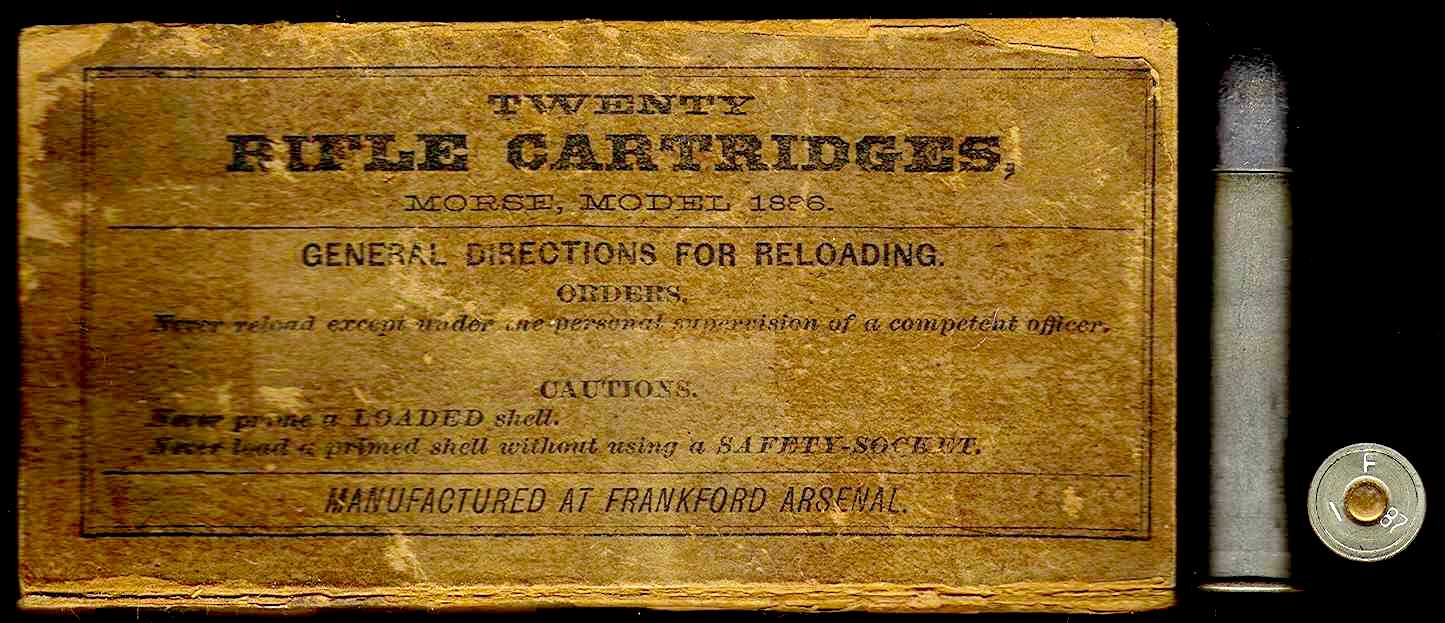
I picked up this tired box of .45-70 Morse 'removeable head' cartridges
(official name "Caliber 45 Rifle Cartridge, Morse Pattern, 1886") in an auction
recently. The cartridges are headstamped 'F 1 87' and the top
of the box is date stamped January 9 (?) 1887. It was a partially filled
box, which was fine with me, as I seldom break up a full box of collectible
cartridges,  but
have no problem taking the cartridges from a partial box to list individually
in my trade stock on the web page. The box was almost entirely covered with
clear tape to hold it together. After half an hour of work with a hair dryer
to soften the adhesive and a knife to lift the edges of the tape, I think
it turned out quite presentable with minimal loss of the label. Unfortunately,
the adhesive from the tape darkened the paper, as can be clearly seen in
the picture. This second picture shows the components of the case from
one of the cartridges that came from this box. The case is made up of three
parts, these being the removeable head, a light colored rubber seal, and
the hull, which is essentially a tube with a flange formed at the base. The
case and head were made of tinned brass, rather than Bloomfield gilding metal,
a copper alloy that had been the standard for military cartridge
production up to that time. The rubber seal fits down inside the removable
head (a line can be seen on the side of the seal where it fit against the
upper edge of the head), and when the head is slipped into place, it covers
the narrow gap between the head and the hull to prevent the escape of gases
when the cartridge is fired. I was surprised to find that the seal was
still 'rubbery' after 117 years. Apparently, these seals were good for more
than one one shot, and the cartridge case was only disassembled when it was
apparent that the head was leaking when the cartridge was fired. The Morse
pattern cartridge was but
have no problem taking the cartridges from a partial box to list individually
in my trade stock on the web page. The box was almost entirely covered with
clear tape to hold it together. After half an hour of work with a hair dryer
to soften the adhesive and a knife to lift the edges of the tape, I think
it turned out quite presentable with minimal loss of the label. Unfortunately,
the adhesive from the tape darkened the paper, as can be clearly seen in
the picture. This second picture shows the components of the case from
one of the cartridges that came from this box. The case is made up of three
parts, these being the removeable head, a light colored rubber seal, and
the hull, which is essentially a tube with a flange formed at the base. The
case and head were made of tinned brass, rather than Bloomfield gilding metal,
a copper alloy that had been the standard for military cartridge
production up to that time. The rubber seal fits down inside the removable
head (a line can be seen on the side of the seal where it fit against the
upper edge of the head), and when the head is slipped into place, it covers
the narrow gap between the head and the hull to prevent the escape of gases
when the cartridge is fired. I was surprised to find that the seal was
still 'rubbery' after 117 years. Apparently, these seals were good for more
than one one shot, and the cartridge case was only disassembled when it was
apparent that the head was leaking when the cartridge was fired. The Morse
pattern cartridge was
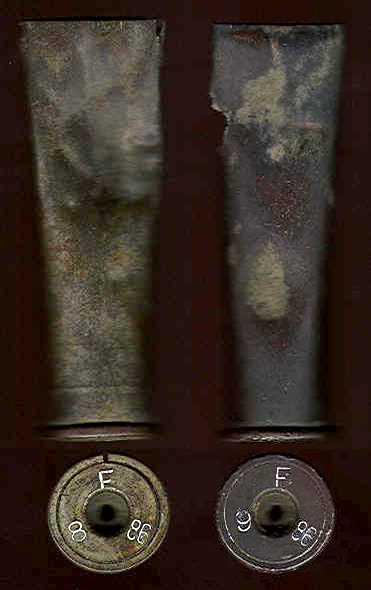 produced by
the Frankford Arsenal in limited numbers beginning in1886. Known headstamps
include F 8 86, F 9 86, F 10 86, F 11 86, F 1 87, and F 2 87. There is also
a 'MODEL 1886' headstamp on experimental versions of the cartridge, as discussed
in Frasca & Hill's book The .45-70 Springfield. Based on its short
period of production, one can assume that the Morse Pattern cartridge case
did not offer enough benefits to warrant adoption as the standard by
the Army. However, they did see use by the troops in the field, as evidenced
by the cartridge cases shown in the third picture. These were found together
at a site near Alkali Station (now Paxton), a stop along the Union Pacific
Railroad on the south side of the North Platte River in Western Nebraska.
Both are Morse Pattern cases, and are headstamped F 8 86 and F 9 86. They
have been flattened, and were probably intentionally damaged in keeping with
General Order No. 13, issued by the War Department on February 16th, 1876,
and intended to prevent serviceable cartridge cases from falling into
the hands of the Indians, who were known to reload them using percussion
primers. While the removable head was not adopted by the Army as the standard
for its ammunition, the tinned brass that was used for the Morse Pattern
cartridge cases was found to be stronger and more resistant to corrosion
than copper, and was selected for the Pattern 1888 cartridge, the standard
production cartridge which made its appearance in October of that year. Because
the standard reloading tools caused damage to the rubber seal, a special
set of tools had to be constructed at the Frankford Arsenal for reloading
the produced by
the Frankford Arsenal in limited numbers beginning in1886. Known headstamps
include F 8 86, F 9 86, F 10 86, F 11 86, F 1 87, and F 2 87. There is also
a 'MODEL 1886' headstamp on experimental versions of the cartridge, as discussed
in Frasca & Hill's book The .45-70 Springfield. Based on its short
period of production, one can assume that the Morse Pattern cartridge case
did not offer enough benefits to warrant adoption as the standard by
the Army. However, they did see use by the troops in the field, as evidenced
by the cartridge cases shown in the third picture. These were found together
at a site near Alkali Station (now Paxton), a stop along the Union Pacific
Railroad on the south side of the North Platte River in Western Nebraska.
Both are Morse Pattern cases, and are headstamped F 8 86 and F 9 86. They
have been flattened, and were probably intentionally damaged in keeping with
General Order No. 13, issued by the War Department on February 16th, 1876,
and intended to prevent serviceable cartridge cases from falling into
the hands of the Indians, who were known to reload them using percussion
primers. While the removable head was not adopted by the Army as the standard
for its ammunition, the tinned brass that was used for the Morse Pattern
cartridge cases was found to be stronger and more resistant to corrosion
than copper, and was selected for the Pattern 1888 cartridge, the standard
production cartridge which made its appearance in October of that year. Because
the standard reloading tools caused damage to the rubber seal, a special
set of tools had to be constructed at the Frankford Arsenal for reloading
the 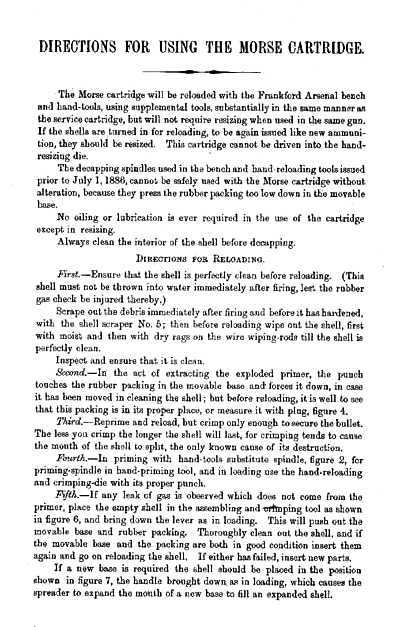 Morse pattern
cartridges. Illustrations of these special tools, and the directions for
using each of the tools in the reloading process are included in these
last two pictures, reproduced from an 1888 Ordnance Department publication. Morse pattern
cartridges. Illustrations of these special tools, and the directions for
using each of the tools in the reloading process are included in these
last two pictures, reproduced from an 1888 Ordnance Department publication.
v
v
v
v
v
v
v
v
v
v
v
v
v
v
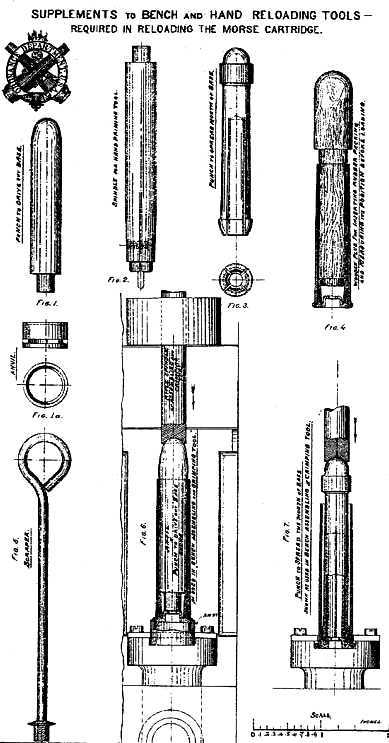 v v
v
v
v
v
v
v
v
v
v
v
v
v
v
v
v
v
v
v
v
v
v
v
v
v
v
v
A box of 9mm WW2 Danish Army Revolver
Cartridges...
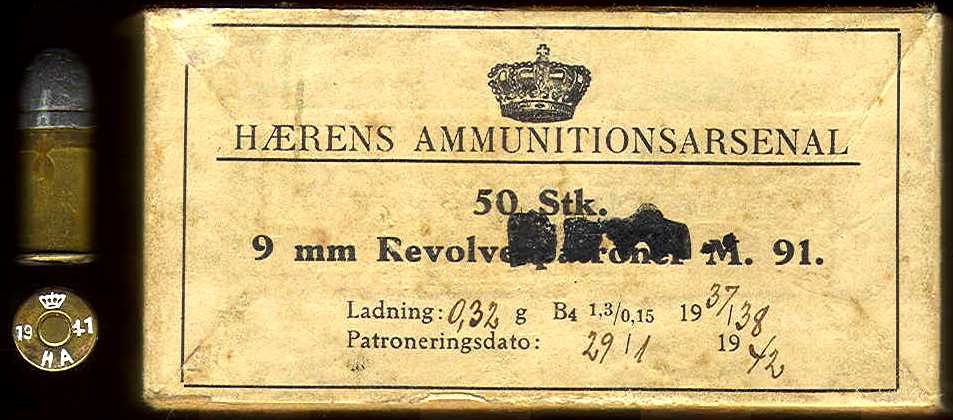 Shown here
is a full box of rimmed 9mm cartridges intended for use in the Danish Model
1891 Army Revolver, and manufactured by the Haerens ammunition arsenal in
Denmark. Apparently, the revolver was well thought of, as it was still in
use during World War 2, as attested to by the 1941 headstamp date and the
January 29, 1942 date on the box label. The cartridge is quite similar to
the .38 Short Colt, the only significant dimensional difference being that
the 9mm case is slightly tapered, measuring .375" Shown here
is a full box of rimmed 9mm cartridges intended for use in the Danish Model
1891 Army Revolver, and manufactured by the Haerens ammunition arsenal in
Denmark. Apparently, the revolver was well thought of, as it was still in
use during World War 2, as attested to by the 1941 headstamp date and the
January 29, 1942 date on the box label. The cartridge is quite similar to
the .38 Short Colt, the only significant dimensional difference being that
the 9mm case is slightly tapered, measuring .375"
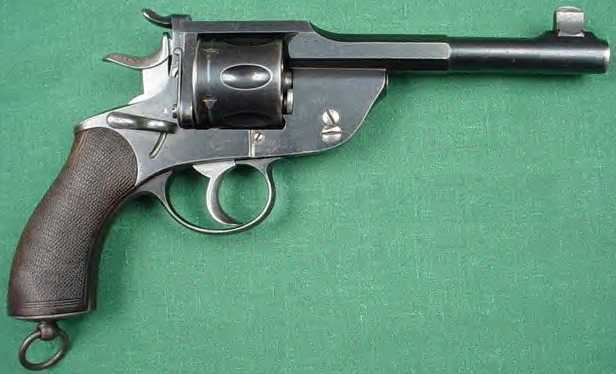 at the mouth
and .386" at the head, while the .38 Short has a straight case measuring
.375". The Danish Model 1891 revolver, shown here, was a cumbersome and somewhat
less than attractive handgun that was obsolete long before this box
of cartridges was produced for it. at the mouth
and .386" at the head, while the .38 Short has a straight case measuring
.375". The Danish Model 1891 revolver, shown here, was a cumbersome and somewhat
less than attractive handgun that was obsolete long before this box
of cartridges was produced for it. |


 but
have no problem taking the cartridges from a partial box to list individually
in my trade stock on the web page. The box was almost entirely covered with
clear tape to hold it together. After half an hour of work with a hair dryer
to soften the adhesive and a knife to lift the edges of the tape, I think
it turned out quite presentable with minimal loss of the label. Unfortunately,
the adhesive from the tape darkened the paper, as can be clearly seen in
the picture. This second picture shows the components of the case from
one of the cartridges that came from this box. The case is made up of three
parts, these being the removeable head, a light colored rubber seal, and
the hull, which is essentially a tube with a flange formed at the base. The
case and head were made of tinned brass, rather than Bloomfield gilding metal,
a copper alloy that had been the standard for military cartridge
production up to that time. The rubber seal fits down inside the removable
head (a line can be seen on the side of the seal where it fit against the
upper edge of the head), and when the head is slipped into place, it covers
the narrow gap between the head and the hull to prevent the escape of gases
when the cartridge is fired. I was surprised to find that the seal was
still 'rubbery' after 117 years. Apparently, these seals were good for more
than one one shot, and the cartridge case was only disassembled when it was
apparent that the head was leaking when the cartridge was fired. The Morse
pattern cartridge was
but
have no problem taking the cartridges from a partial box to list individually
in my trade stock on the web page. The box was almost entirely covered with
clear tape to hold it together. After half an hour of work with a hair dryer
to soften the adhesive and a knife to lift the edges of the tape, I think
it turned out quite presentable with minimal loss of the label. Unfortunately,
the adhesive from the tape darkened the paper, as can be clearly seen in
the picture. This second picture shows the components of the case from
one of the cartridges that came from this box. The case is made up of three
parts, these being the removeable head, a light colored rubber seal, and
the hull, which is essentially a tube with a flange formed at the base. The
case and head were made of tinned brass, rather than Bloomfield gilding metal,
a copper alloy that had been the standard for military cartridge
production up to that time. The rubber seal fits down inside the removable
head (a line can be seen on the side of the seal where it fit against the
upper edge of the head), and when the head is slipped into place, it covers
the narrow gap between the head and the hull to prevent the escape of gases
when the cartridge is fired. I was surprised to find that the seal was
still 'rubbery' after 117 years. Apparently, these seals were good for more
than one one shot, and the cartridge case was only disassembled when it was
apparent that the head was leaking when the cartridge was fired. The Morse
pattern cartridge was
 produced by
the Frankford Arsenal in limited numbers beginning in1886. Known headstamps
include F 8 86, F 9 86, F 10 86, F 11 86, F 1 87, and F 2 87. There is also
a 'MODEL 1886' headstamp on experimental versions of the cartridge, as discussed
in Frasca & Hill's book The .45-70 Springfield. Based on its short
period of production, one can assume that the Morse Pattern cartridge case
did not offer enough benefits to warrant adoption as the standard by
the Army. However, they did see use by the troops in the field, as evidenced
by the cartridge cases shown in the third picture. These were found together
at a site near Alkali Station (now Paxton), a stop along the Union Pacific
Railroad on the south side of the North Platte River in Western Nebraska.
Both are Morse Pattern cases, and are headstamped F 8 86 and F 9 86. They
have been flattened, and were probably intentionally damaged in keeping with
General Order No. 13, issued by the War Department on February 16th, 1876,
and intended to prevent serviceable cartridge cases from falling into
the hands of the Indians, who were known to reload them using percussion
primers. While the removable head was not adopted by the Army as the standard
for its ammunition, the tinned brass that was used for the Morse Pattern
cartridge cases was found to be stronger and more resistant to corrosion
than copper, and was selected for the Pattern 1888 cartridge, the standard
production cartridge which made its appearance in October of that year. Because
the standard reloading tools caused damage to the rubber seal, a special
set of tools had to be constructed at the Frankford Arsenal for reloading
the
produced by
the Frankford Arsenal in limited numbers beginning in1886. Known headstamps
include F 8 86, F 9 86, F 10 86, F 11 86, F 1 87, and F 2 87. There is also
a 'MODEL 1886' headstamp on experimental versions of the cartridge, as discussed
in Frasca & Hill's book The .45-70 Springfield. Based on its short
period of production, one can assume that the Morse Pattern cartridge case
did not offer enough benefits to warrant adoption as the standard by
the Army. However, they did see use by the troops in the field, as evidenced
by the cartridge cases shown in the third picture. These were found together
at a site near Alkali Station (now Paxton), a stop along the Union Pacific
Railroad on the south side of the North Platte River in Western Nebraska.
Both are Morse Pattern cases, and are headstamped F 8 86 and F 9 86. They
have been flattened, and were probably intentionally damaged in keeping with
General Order No. 13, issued by the War Department on February 16th, 1876,
and intended to prevent serviceable cartridge cases from falling into
the hands of the Indians, who were known to reload them using percussion
primers. While the removable head was not adopted by the Army as the standard
for its ammunition, the tinned brass that was used for the Morse Pattern
cartridge cases was found to be stronger and more resistant to corrosion
than copper, and was selected for the Pattern 1888 cartridge, the standard
production cartridge which made its appearance in October of that year. Because
the standard reloading tools caused damage to the rubber seal, a special
set of tools had to be constructed at the Frankford Arsenal for reloading
the  Morse pattern
cartridges. Illustrations of these special tools, and the directions for
using each of the tools in the reloading process are included in these
last two pictures, reproduced from an 1888 Ordnance Department publication.
Morse pattern
cartridges. Illustrations of these special tools, and the directions for
using each of the tools in the reloading process are included in these
last two pictures, reproduced from an 1888 Ordnance Department publication.
 v
v
 Shown here
is a full box of rimmed 9mm cartridges intended for use in the Danish Model
1891 Army Revolver, and manufactured by the Haerens ammunition arsenal in
Denmark. Apparently, the revolver was well thought of, as it was still in
use during World War 2, as attested to by the 1941 headstamp date and the
January 29, 1942 date on the box label. The cartridge is quite similar to
the .38 Short Colt, the only significant dimensional difference being that
the 9mm case is slightly tapered, measuring .375"
Shown here
is a full box of rimmed 9mm cartridges intended for use in the Danish Model
1891 Army Revolver, and manufactured by the Haerens ammunition arsenal in
Denmark. Apparently, the revolver was well thought of, as it was still in
use during World War 2, as attested to by the 1941 headstamp date and the
January 29, 1942 date on the box label. The cartridge is quite similar to
the .38 Short Colt, the only significant dimensional difference being that
the 9mm case is slightly tapered, measuring .375"
 at the mouth
and .386" at the head, while the .38 Short has a straight case measuring
.375". The Danish Model 1891 revolver, shown here, was a cumbersome and somewhat
less than attractive handgun that was obsolete long before this box
of cartridges was produced for it.
at the mouth
and .386" at the head, while the .38 Short has a straight case measuring
.375". The Danish Model 1891 revolver, shown here, was a cumbersome and somewhat
less than attractive handgun that was obsolete long before this box
of cartridges was produced for it.